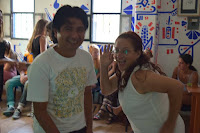To be or not to be local? Monday 3/28
Food Systems students were greeted by professor Vern Grubinger for the week to study farming and food system of Oaxaca. 1st stop - Central de Abastos Market. This market is where almost all items, food and non-food, first come into the city, which makes sense because "Central de Abasto" translates into "Center of Supply". The market is the size of multiple football fields crowded with people, smells, and sounds. The mission of our trip was to find out where different food items are being produced by talking to different vendors. We learned from a butcher that a lot of livestock is raised in Chiapas then slaughtered in Oaxaca. We learned that a lot of vegetables come from Veracruz and Puebla. Leaving Abastos that day, we definitely gained a more solid understanding of the Oaxacan food system, as well as an understanding of how much the actors in the food system (vendors, cooks etc.) actually know about the food that they're selling.
Children of the Corn! Tuesday 3/29 and Wednesday 3/30
The next two days we were jam packed with knowledge! We first headed to INIFAP (Instituto Nacional De Investigaciones Forestales, Agrícolas Y Pecuarias), a federal research and extension center station that is working to protect local maize genetics. We learned about corn production, corn markets, and the pollination process. We even got to visit their seed bank full of colorful rows of native corn. Blue and purple corns are higher in protein, so put down that burger and grab an elote (corn on the cob)!
We stayed in a small village about four hours north of the city called Santa Maria Yaviche. It's a small village that produces coffee as a cash crop, but also produces a lot of sugar cane. We learned about the economics of their coffee selling, how the majority of it is organic and we also learned about a plague called La Rolla, which has been devastating coffee trees all over Central and South America in the past two years. We learned how this is devastating their main cash crop, but they can still sustain themselves because nearly everyone in the village grows their own food.
Thursday, we went to go see the cattle market in Zaachila, which is a small town south of Oaxaca city. The market only happens on Thursdays and we got there at around noon. There was a lot of ganado (cattle), borregos y chivos (goat and sheep) and guajolotes y gallinas (turkeys and chickens). You could buy a pair of work oxen, a yunta, for 45,000 pesos or about 2,500 USD. There was a lot of action going on, a lot of men inspecting different animals, people leading five goats down the street, people yelling about how their animals are "bien chulos!" or "nice and cool/fat/delicious!". There are also stands on the sides that are selling items catered to these cattlemen: spurs for cowboy boots, leather whips, saddles and other things related to livestock. For lunch, we stopped at a stand and got tacos de barbacoa, which are goat meat tacos, very delicious. From this trip, we got a better perspective of where all the meat in town comes from and what the realities are of raising the livestock that eventually end in our tacos.
Healthy looking ganado.
Friday 4/1
Today, our teachers decided to just give us the day off. April fools! We actually went to go see a large scale, organic, heirloom tomato operation. The operation is six acres of greenhouses and exports to Los Angeles. The owner explained to us the challenges of being organic, how he found his buyers in the United States, why he decided to go into a different market and how the tomatoes are grown. We saw inside of the invernaderos (greenhouses) and saw the different organic fertilizers that they use. They also produce a lot of organic cucumbers, and we got to try some of those. Muy delicioso!
The owner of the greenhouse showing us some compost tea that is applied to plants
After the greenhouses, we took a tour of Universidad Technológica de los Valles Centrales de Oaxaca (Technological University of the Central Valleys of Oaxaca.) This was a cool experience because we got to feel what is like to be back on a college campus again, with all the buzz of kids and people rushing to class and people hanging out under trees. The technological university offers degrees in gastronomy, mechanical engineering, nutrition and food science, business, agronomy and sustainable energy. Definitely interesting to see the similarities and differences between this university and UVM.
Saturday 4/2
Today we had a talk with a coffee co-op called Yeni Navan (Zapotec for "New Light"). We learned how the organization is a combination of more than forty coffee producing villages and how it's all certified organic. We talked to the president of the organization and learned about the economics of it all, how paying for organic and fair trade certification is really expensive, but it works out because they can sell for a significantly higher price. We learned how in normal years in the past, the organization was producing a combined five hundred tons of coffee, but with the La Rolla plague, they will probably only be able to produce two hundred fifty. He explained how the buyers of their coffee exert a lot of pressure on them to meet the demand, but he remained optimistic that the coffee trees will beat the plague, telling us how there is a lot of research being done in Mexico about fighting it and resistant trees.
Sara Jean with some delicious, local coffee.
Food Systems had a great week. Hasta luego!
Vanessa y Mateo
























